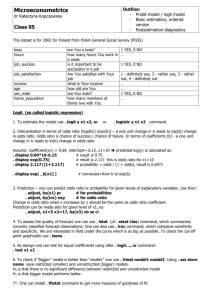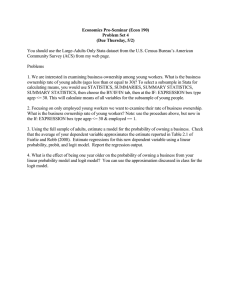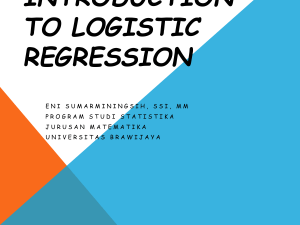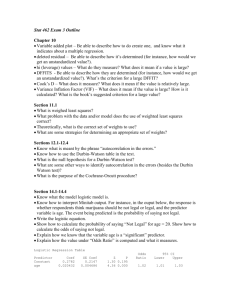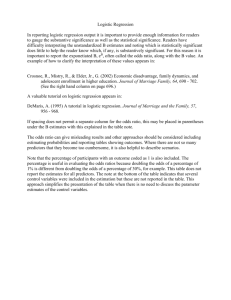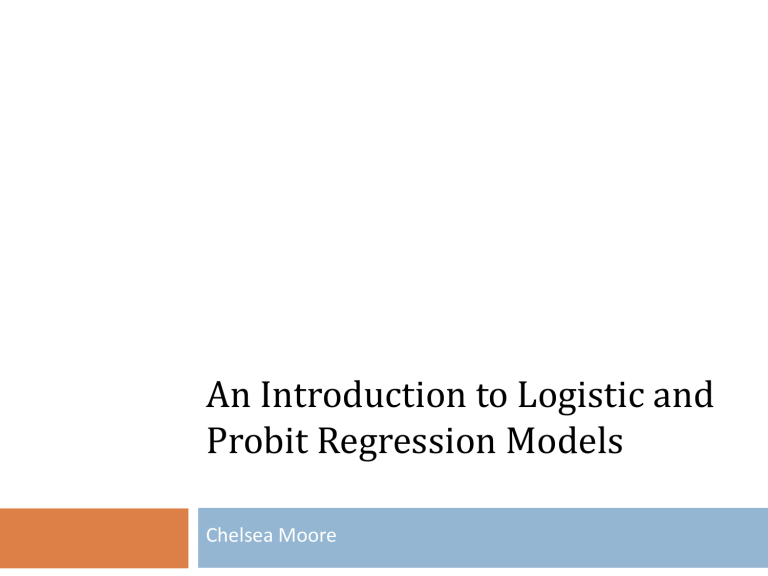
An Introduction to Logistic and Probit Regression Models Chelsea Moore Goals • Brief overview of logistic and probit models • Example in Stata • Interpretation within & between models Binary Outcome • Examples: • Yes/No • Success/Failure • Heart Attack/No Heart Attack • In/Out of the Labor Force Modeling a Binary Outcome • Latent Variable Approach We can think of y* as the underlying latent propensity that y=1 • • • Example 1: For the binary variable, heart attack/no heart attack, y* is the propensity for a heart attack. Example 2: For the binary variable, in/out of the labor force, y* is the propensity to be in the labor force. 𝑦𝑦 ∗ = 𝛼𝛼 + 𝛽𝛽𝛽𝛽 + 𝜀𝜀 1 if y *i > τ yi = 0 if y *i ≤ τ Where τ is the threshold Logit versus Probit • • Since y* is unobserved, we use do not know the distribution of the errors, ε In order to use maximum likelihood estimation (ML), we need to make some assumption about the distribution of the errors. Logit versus Probit • • The difference between Logistic and Probit models lies in this assumption about the distribution of the errors Logit • • 𝑘𝑘=0 Standard logistic distribution of errors Probit • 𝑘𝑘=𝑛𝑛 𝑝𝑝𝑖𝑖 � = � 𝛽𝛽𝑘𝑘 𝑥𝑥𝑖𝑖𝑖𝑖 ln � (1 − 𝑝𝑝𝑖𝑖 ) 𝑘𝑘=𝑛𝑛 𝛷𝛷 −1 (𝑝𝑝𝑖𝑖 ) = � 𝛽𝛽𝑘𝑘 𝑥𝑥𝑖𝑖𝑖𝑖 𝑘𝑘=0 Normal distribution of errors Probability Density Function (PDF)and Cumulative Distribution Function (CDF) Source: Park (2010) Which to choose? • • Results tend to be very similar Preference for one over the other tends to vary by discipline Simple Example in Stata • Data: NLSY 97 • Sample: BA degree earners • Dependent Variable: Entry into a STEM occupation • Independent Variable: Parent education (categorical variable of highest degree: 2-year degree or lower versus BA and Advanced Degree) Stata Output: Logit Interpretation • Logistic Regression • Log odds • Interpretation: Among BA earners, having a parent whose highest degree is a BA degree versus a 2-yr degree or less increases the log odds of entering a STEM job by 0.477. Interpretation • Logistic Regression • Log odds • • Interpretation: Among BA earners, having a parent whose highest degree is a BA degree versus a 2-year degree or less increases the log odds by 0.477. However, we can easily transform this into odds ratios by exponentiating the coefficients: exp(0.477)=1.61 • Interpretation: BA degree earners with a parent whose highest degree is a BA degree are 1.61 times more likely to enter into a STEM occupation than those with a parent who have a 2-year degree or less. Stata Output: logistic • “logistic” command outputs odds ratios instead of log odds Stata Output: probit Interpretation • Probit Regression • Z-scores • • Interpretation: Among BA earners, having a parent whose highest degree is a BA degree versus a 2-year degree or less increases the z-score by 0.263. Researchers often report the marginal effect, which is the change in y* for each unit change in x. Comparison of Coefficients Variable Logistic Coefficient Probit Coefficient Ratio Parent Ed: BA Deg .4771 .2627 1.8 Parent Ed: Advanced .3685 Deg .2015 1.8 Comparing Across Models • It can be misleading to compare coefficients across models because the variance of the underlying latent variable (y*) is not identified and can differ across models. Some Possible Solutions to this Problem: • Predicted Probabilities • • y*-standardized coefficients • • Bksy* gives the standard deviation increase in y* given a one unit increase in xk,, holding all other variables constant. Fully standardized coefficients • • Gives predicted values at substantively meaningful values of xk Bks gives the standard deviation increase in in y*, given a one standard deviation increase in xk, holding all other variables constant. Marginal effects • The slope of the probability curve relating x to Pr(y=1|x), holding all other variables constant A Few Examples of Hypothesis Testing and Model Fit for Logistic Regression in Stata • Likelihood Ratio • • Wald test • • test Akaike’s Information Criterion (AIC)/Bayesian Information Criterion (BIC) • • lrtest estat ic Or for a variety of fit statistics • fitstat References • • • Agresti, Alan. An introduction to categorical data analysis. Vol. 423. Wiley-Interscience, 2007. Long, J. Scott. Regression models for categorical and limited dependent variables. Vol. 7. Sage, 1997. Powers, D., and Y. Xie. "Statistical method for categorical data analysis Academic Press." San Deigo, CA (2000).

